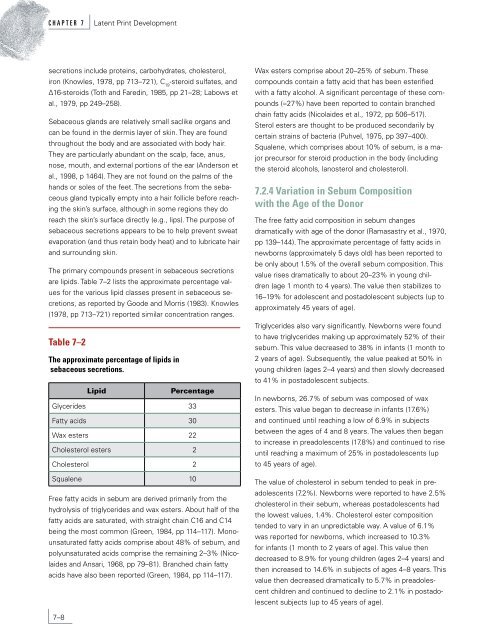Latent Print Development - National Criminal Justice Reference ...
Latent Print Development - National Criminal Justice Reference ...
Latent Print Development - National Criminal Justice Reference ...
You also want an ePaper? Increase the reach of your titles
YUMPU automatically turns print PDFs into web optimized ePapers that Google loves.
C H A P T E R 7 <strong>Latent</strong> <strong>Print</strong> <strong>Development</strong><br />
secretions include proteins, carbohydrates, cholesterol,<br />
iron (Knowles, 1978, pp 713–721), C 19 -steroid sulfates, and<br />
∆16-steroids (Toth and Faredin, 1985, pp 21–28; Labows et<br />
al., 1979, pp 249–258).<br />
Sebaceous glands are relatively small saclike organs and<br />
can be found in the dermis layer of skin. They are found<br />
throughout the body and are associated with body hair.<br />
They are particularly abundant on the scalp, face, anus,<br />
nose, mouth, and external portions of the ear (Anderson et<br />
al., 1998, p 1464). They are not found on the palms of the<br />
hands or soles of the feet. The secretions from the seba-<br />
ceous gland typically empty into a hair follicle before reach-<br />
ing the skin’s surface, although in some regions they do<br />
reach the skin’s surface directly (e.g., lips). The purpose of<br />
sebaceous secretions appears to be to help prevent sweat<br />
evaporation (and thus retain body heat) and to lubricate hair<br />
and surrounding skin.<br />
The primary compounds present in sebaceous secretions<br />
are lipids. Table 7–2 lists the approximate percentage val-<br />
ues for the various lipid classes present in sebaceous se-<br />
cretions, as reported by Goode and Morris (1983). Knowles<br />
(1978, pp 713–721) reported similar concentration ranges.<br />
Table 7–2<br />
The approximate percentage of lipids in<br />
sebaceous secretions.<br />
Lipid Percentage<br />
Glycerides 33<br />
Fatty acids 30<br />
Wax esters 22<br />
Cholesterol esters 2<br />
Cholesterol 2<br />
Squalene 10<br />
Free fatty acids in sebum are derived primarily from the<br />
hydrolysis of triglycerides and wax esters. About half of the<br />
fatty acids are saturated, with straight chain C16 and C14<br />
being the most common (Green, 1984, pp 114–117). Mono-<br />
unsaturated fatty acids comprise about 48% of sebum, and<br />
polyunsaturated acids comprise the remaining 2–3% (Nico-<br />
laides and Ansari, 1968, pp 79–81). Branched chain fatty<br />
acids have also been reported (Green, 1984, pp 114–117).<br />
7–8<br />
Wax esters comprise about 20–25% of sebum. These<br />
compounds contain a fatty acid that has been esterified<br />
with a fatty alcohol. A significant percentage of these com-<br />
pounds (≈27%) have been reported to contain branched<br />
chain fatty acids (Nicolaides et al., 1972, pp 506–517).<br />
Sterol esters are thought to be produced secondarily by<br />
certain strains of bacteria (Puhvel, 1975, pp 397–400).<br />
Squalene, which comprises about 10% of sebum, is a ma-<br />
jor precursor for steroid production in the body (including<br />
the steroid alcohols, lanosterol and cholesterol).<br />
7.2.4 Variation in Sebum Composition<br />
with the Age of the Donor<br />
The free fatty acid composition in sebum changes<br />
dramatically with age of the donor (Ramasastry et al., 1970,<br />
pp 139–144). The approximate percentage of fatty acids in<br />
newborns (approximately 5 days old) has been reported to<br />
be only about 1.5% of the overall sebum composition. This<br />
value rises dramatically to about 20–23% in young chil-<br />
dren (age 1 month to 4 years). The value then stabilizes to<br />
16–19% for adolescent and postadolescent subjects (up to<br />
approximately 45 years of age).<br />
Triglycerides also vary significantly. Newborns were found<br />
to have triglycerides making up approximately 52% of their<br />
sebum. This value decreased to 38% in infants (1 month to<br />
2 years of age). Subsequently, the value peaked at 50% in<br />
young children (ages 2–4 years) and then slowly decreased<br />
to 41% in postadolescent subjects.<br />
In newborns, 26.7% of sebum was composed of wax<br />
esters. This value began to decrease in infants (17.6%)<br />
and continued until reaching a low of 6.9% in subjects<br />
between the ages of 4 and 8 years. The values then began<br />
to increase in preadolescents (17.8%) and continued to rise<br />
until reaching a maximum of 25% in postadolescents (up<br />
to 45 years of age).<br />
The value of cholesterol in sebum tended to peak in pre-<br />
adolescents (7.2%). Newborns were reported to have 2.5%<br />
cholesterol in their sebum, whereas postadolescents had<br />
the lowest values, 1.4%. Cholesterol ester composition<br />
tended to vary in an unpredictable way. A value of 6.1%<br />
was reported for newborns, which increased to 10.3%<br />
for infants (1 month to 2 years of age). This value then<br />
decreased to 8.9% for young children (ages 2–4 years) and<br />
then increased to 14.6% in subjects of ages 4–8 years. This<br />
value then decreased dramatically to 5.7% in preadoles-<br />
cent children and continued to decline to 2.1% in postado-<br />
lescent subjects (up to 45 years of age).

















